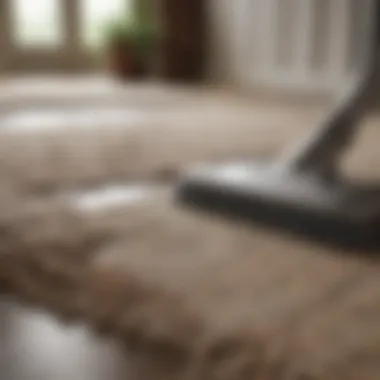The Best Techniques for Shampooing Area Rugs


Intro
When it comes to maintaining the appearance and longevity of area rugs, proper cleaning is crucial. These decorative textiles not only enhance the aesthetics of a living space but also serve functional purposes like sound absorption and insulation. However, they are often subject to spills, dirt, and wear over time, necessitating regular cleaning practices to keep them looking fresh and inviting.
Shampooing area rugs is a method that can effectively remove embedded dirt and stains, preserving the integrity of the fibers. This guide will delve into the steps and considerations involved in shampooing area rugs, providing insights into materials, cleaning techniques, and the unique needs of various rug types. By understanding these elements, homeowners can execute cleaning regimens that are both effective and safe for their rugs.
Feature Spotlight
Exceptional Cleaning Techniques
Cleaning area rugs involves acknowledging the various factors that can affect their structure and appearance. Different materials such as wool, cotton, and synthetic fibers each have unique cleaning requirements. Understanding these requirements is essential for choosing the right method and products.
- Wool Rugs: These require gentle handling, as harsh chemicals can damage the fibers. Using pH-balanced shampoo is often recommended.
- Synthetic Rugs: These are more durable and can withstand stronger cleaning agents. Using regular carpet shampoo is usually sufficient.
By selecting the appropriate shampoo and cleaning technique based on rug material, homeowners can enhance not only the rug's appearance but also its lifespan.
Unique Care Elements
Using the correct tools is just as vital as selecting the right cleaning products. Homeowners should consider the following when shampooing area rugs:
- Vacuum Cleaner: It should have appropriate settings for rugs to avoid pulling threads.
- Shampoo Applicator: A professional-grade shampoo applicator can ensure even distribution.
Additionally, incorporating protective measures such as using a rug pad can help prevent dirt accumulation.
"Understanding the specific needs of different rug materials enhances both cleaning efficacy and longevity of the rugs."
Location Highlights
Cleaning Environment
The environment where cleaning takes place can impact results. It is best to shampoo area rugs in a well-ventilated space to allow proper drying. Also, ensuring that the rug is stripped of any loose dirt beforehand prepares it for effective cleaning.
The Importance of Following Directions
When using any cleaning products, following the manufacturer’s instructions can help prevent accidents and damaging results. This includes diluting shampoo properly and avoiding oversaturation.
By understanding and implementing these points, homeowners can achieve stunning visual results in their area rugs, prolonging their service and enhancing their living spaces.
Understanding Area Rugs


Area rugs play a significant role in any living space. Their influence extends beyond mere aesthetics; they provide comfort and warmth, define spaces, and even contribute to sound absorption. Understanding the nuances of area rugs can greatly enhance homeowners' cleaning and maintenance practices, ensuring the longevity and visual appeal of these textile investments. This section aims to elucidate the various types of area rugs, their common uses, and the benefits they provide, forming a comprehensive foundation for effective shampooing methodologies.
Types of Area Rugs
Natural Fibers
Natural fiber rugs are made from materials like wool, cotton, jute, and sisal. Their organic composition is a key characteristic, promoting breathable qualities. These rugs are often praised for their durability and luxurious feel, making them a popular choice in various homes. Wool, for instance, is particularly advantageous due to its natural stain resistance and resilience, though it may be more susceptible to fading in direct sunlight. On the downside, natural fibers can be harder to clean and may require specific care depending on the material.
Synthetic Fibers
Synthetic fiber rugs, constructed from materials such as nylon, polyester, and polypropylene, offer distinct benefits. They are generally more affordable than their natural counterparts and often come with stain-resistant treatments, making them easier to maintain. One notable feature of synthetic rugs is their colorfastness, which prevents fading over time. However, they might lack the luxurious texture and durability of natural fibers, and they can sometimes retain static electricity, which can be a minor inconvenience.
Woven vs. Tufted
The construction method of area rugs greatly affects their characteristics. Woven rugs are typically made on a loom, ensuring a tighter and more durable fabric. This aspect is appealing for long-term use, but these rugs can be more expensive. On the other hand, tufted rugs are created by punching yarn through a backing material, making them softer but possibly less durable compared to woven rugs. Understanding these construction methods is essential for homeowners, as it impacts both cleaning methods and frequency.
Common Uses and Benefits
Design Enhancement
Area rugs significantly enhance the design of any interior. They can add color and texture, serving as a focal point in a room. A well-chosen rug can tie together various colors and patterns, creating a cohesive design aesthetic. However, selecting the wrong rug may clash with existing décor, which is a consideration that homeowners should keep in mind.
Sound Absorption
Another essential benefit of area rugs is their ability to absorb sound. The fibers and pile of these rugs can reduce noise levels, making spaces feel cozier and quieter. This characteristic is particularly valuable in urban settings or homes with multiple levels. However, it is vital to recognize that not all rug types offer the same level of sound insulation.
Warmth and Comfort
One cannot overlook the warmth and comfort that area rugs provide. They can make a cold floor feel inviting, adding an element of comfort underfoot. This aspect becomes especially crucial in rooms such as living rooms and bedrooms, where comfort is paramount. Despite their many advantages, certain types of rugs may not be suitable for high-traffic areas, as they can wear down faster or be more challenging to clean.
Understanding the specifics of area rugs allows homeowners to make informed choices not just for aesthetics but for cleaning and maintenance as well.
Preparing for Shampooing
Proper preparation is crucial before shampooing an area rug. This stage ensures that the cleaning process is efficient and doesn’t inadvertently cause any damage. By taking these steps, one can enhance the effectiveness of the cleaning while preserving the integrity and aesthetics of the rug. A systematic approach to preparation can lead to a noticeable difference in the cleanliness and longevity of the rug.
Assessing the Rug Condition
Identifying Stains
Identifying stains on the rug is the first step in the cleaning process. Stains can vary in type, from food spills to pet accidents. These stains not only affect the appearance but also the material of the rug. The key aspect of identifying stains is to recognize the source and age of each stain. This knowledge is beneficial as it helps in selecting the appropriate cleaning methods and products. The unique feature of this step is that it guides the entire cleaning strategy, ensuring specific treatments are applied to stubborn stains. One disadvantage might be that if stains are not detected properly, residual marks could remain, which defeats the cleaning purpose.


Checking for Damage
Checking for damage is another critical component of preparing for shampooing. This includes looking for fraying edges, worn patches, or any signs of previous repairs. Identifying damage helps the homeowner understand the rug's vulnerability. This is crucial, as damaged fibers require special care. The key characteristic here is that being aware of these flaws can help prevent worsening the damage during cleaning.
Understanding the condition prevents the use of harsh cleaning methods that could exacerbate existing issues. A downside of this step is that some damage may not be immediately visible, leading to potential mishaps during cleaning.
Understanding Fiber Type
Understanding fiber type is a major consideration when preparing to shampoo. Different materials, such as wool, silk, or synthetic fibers, react differently to cleaning solutions. This step is essential to determine the safest and most effective cleaning methods. The distinctive feature of this process is how it informs product selection; for example, using a mild detergent on delicate fibers is crucial. The benefit of understanding the fiber is that it leads to better care in the long run, enhancing the rug's durability. On the flip side, a lack of this knowledge could lead to damage, making the rug unusable.
Essential Tools and Materials
Quality Shampoo
Quality shampoo plays a pivotal role in cleaning rugs effectively. The right shampoo can break down dirt and odors without harming the fibers. A key characteristic of quality shampoos is their formulation; those made for specific fiber types can yield superior results. In this article, selecting the right shampoo is emphasized as it contributes to both cleanliness and the maintenance of the rug’s aesthetic. A unique feature is the concentration of active cleaning ingredients which can be adjusted based on the rug’s needs. The downside could be the cost, as high-quality options may be pricier.
Cleaning Tools
Using appropriate cleaning tools is essential for maintaining an area rug’s condition. Tools like brushes, sponges, and microfiber cloths are important for effective cleaning. A critical aspect is that the tools must be suitable for the rug’s fabric type and stain level.
The unique feature of using the right tools is that they can help to prevent the fibers from becoming matted or damaged during cleaning. The disadvantage here may include having multiple specialized tools for different kinds of rugs.
Protective Gear
Incorporating protective gear during cleaning is often overlooked but crucial for a successful shampooing process. Understanding the need for gloves, knee padding, or masks can safeguard against chemical exposure or physical strain. The emphasis on protective gear is the prevention of injuries and skin irritations.
Additionally, this gear enhances comfort during the shampooing process. However, one issue might be the added time to put on and prepare these items, which some might consider unnecessary.
Methodologies for Shampooing
The section focuses on various methods for shampooing area rugs. This understanding is vital since the choice of methodology directly impacts the effectiveness of cleaning and the preservation of the rug's integrity. Different rugs have distinct fibers and weaves that respond uniquely to cleaning processes. Therefore, identifying suitable methodologies helps in selecting the right approach and avoiding potential damage. The benefits here include maintaining the rug's aesthetic appeal and extending its lifespan.
Best Practices for Rug Care
Proper care for area rugs is crucial in maintaining their beauty and longevity. This section elaborates on best practices that ensure rugs remain in excellent condition. By implementing these practices, homeowners can not only protect their investment but also enhance the overall aesthetic of their spaces.
Routine Maintenance
Routine maintenance is essential to keeping area rugs looking fresh. It involves regular tasks that help to avoid dirt build-up and extend the life of the rug.
Regular Vacuuming
Regular vacuuming is a fundamental practice. It removes surface dirt and debris which, if left unattended, can contribute to premature wear. The key characteristic of regular vacuuming is its simplicity; it only requires a few minutes of your time and can drastically reduce the frequency of more intensive cleaning. Additionally, using a vacuum with a brush attachment can help to disentangle fibers, maintaining the plush look of the rug.
The unique feature of this technique is that it can often be done without a professional’s help. However, care must be taken with fragile fibers to prevent damage. Over-vacuuming can sometimes cause fraying, so it's important to choose the right setting for different rug types.


Spot Cleaning Techniques
Spot cleaning techniques are invaluable when it comes to handling spills quickly. This method helps to prevent stains from setting in by addressing issues on the spot. The beneficial aspect of spot cleaning is that it is often simple and involves common household items like mild detergent and water.
The unique feature of this technique lies in its immediate nature. By taking action as soon as an accident occurs, homeowners can mitigate potential damage and maintain the rug’s color and texture. However, it's important to ensure that the cleaning materials used are appropriate for the specific type of rug fiber to prevent further issues.
Protective Measures
Implementing protective measures can elevate the durability of area rugs. This includes using rug pads that prevent slipping and provide additional cushioning. The key characteristic here is prevention; these measures are about stopping potential problems before they arise. In addition to rug pads, regular repositioning of rugs can mitigate sunlight damage.
The advantage of protective measures is clear; they not only help in maintaining aesthetics but also prolong the material's lifespan. However, these methods might require some initial investment, which can be a concern for some homeowners. Nevertheless, the long-term benefits often outweigh these costs.
When to Seek Professional Help
Even with the best practices, certain situations may require the assistance of professionals. Understanding when to call in experts can save time and ensure quality care.
Identifying Severe Issues
Identifying severe issues like deep stains, odors, or damaged areas is vital. These problems often indicate that simple solutions won't suffice. The awareness of recognizing these issues is crucial for maintaining the integrity of the rug. It allows homeowners to act swiftly and seek professional guidance when necessary.
For instance, a deeply embedded stain may require specialized treatments that regular cleaning cannot provide. The ability to distinguish between routine maintenance and severe issues can safeguard your rug against potential irreversible damage.
Understanding Cost-Benefit Analysis
Understanding cost-benefit analysis involves weighing the financial outlay for professional cleaning against the potential risks of DIY attempts. This understanding is essential in making informed decisions. If the costs of damage repair exceed the price of professional cleaning, it is sensible to opt for expert services.
The unique aspect of this analysis is that it helps avoid unnecessary expenses while ensuring the longevity of the rug. However, meticulous consideration is required, as sometimes professional costs can vary widely.
Choosing the Right Services
Choosing the right cleaning services is a critical step in the care of area rugs. Different companies may offer various specialties and methods that can affect the outcome. The key characteristic of this choice is due diligence; research is required to find a reputable service that aligns with your rug's needs.
The unique feature of selecting professional help lies in the peace of mind it can provide. A trustworthy service often guarantees satisfaction and offers damage protection, yet it may come with a higher price tag. It's important to balance service quality with budget considerations.
Closure
Rug cleaning is often overlooked, yet regular maintenance can prevent the accumulation of dirt and allergens, benefiting indoor air quality. Moreover, recognizing when to escalate issues from at-home care to professional cleaning can save time and money in the long run. The detailed methodologies provided allow homeowners to make informed decisions tailored to their rugs' needs.
"Regular maintenance of area rugs is critical to their long-term beauty and health."
Summary of Key Points
- Understanding fibers: Different rug materials require specific shampooing techniques.
- Preparation is crucial: Assessing the rug's condition before cleaning can prevent damage.
- Manual vs machine tools: Selecting the appropriate cleaning tools impacts the effectiveness of the cleaning process.
- Routine maintenance: Regular vacuuming and prompt stain correction are essential practices.
- Professional help: Knowing when to seek professional services ensures thorough care for any severe damage or issues.
Final Recommendations
- Always start by checking the manufacturer's instructions for specific care guidelines related to the rug.
- Use high-quality, pH-balanced shampoos that suit the rug's fiber type to avoid irritation or color fading.
- Test cleaning products on a small hidden area before full application to ensure no adverse effects.
- Schedule regular cleanings, factoring in high-traffic areas where dirt accumulates quicker.
- When in doubt, consult a professional cleaning service for a thorough assessment and treatment for complex issues.







